You’ve gotten this far without OCM, why incorporate it now?
Have you heard of OCM? Perhaps you thought it was little more than another vague acronym floating around the corporate workplace that means something to the effect of “we need to pay more attention to the impacts of our changes… somehow.”
OCM sometimes stands for Organizational Change Management, sometimes Operational Change Management. You may even see it referred to as Business Change Management or even Implementation Management. But no matter how your company refers to change management, the most important thing to remember is that OCM ultimately incorporates any element of a change that impacts PEOPLE!
So, why do you need an OCM Strategy? Here are 10 Reasons:

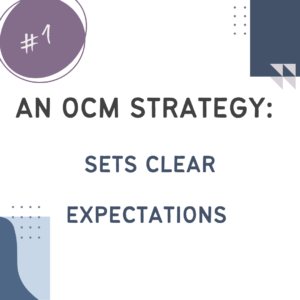

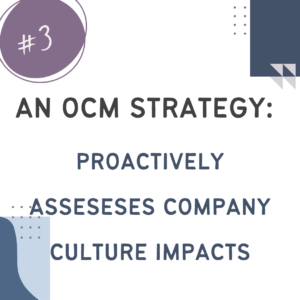
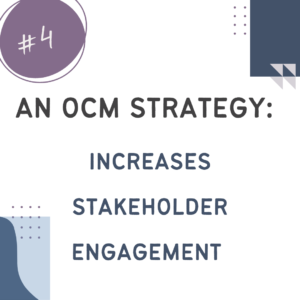
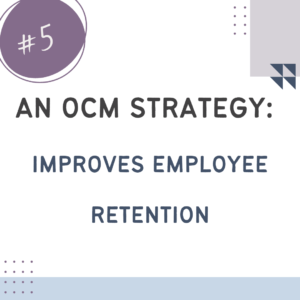
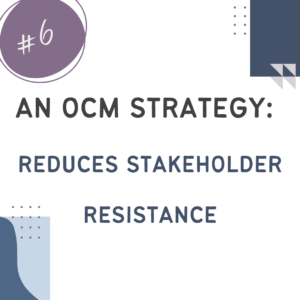
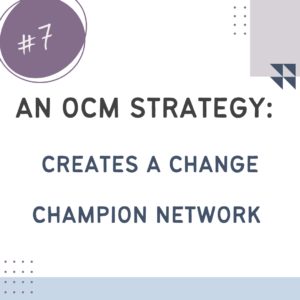
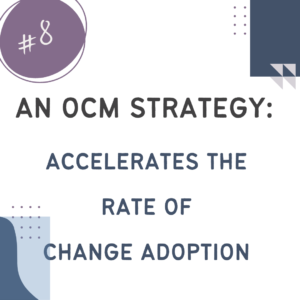
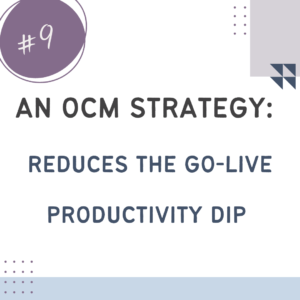

Want to learn More?
Keep Scrolling

1. An OCM Strategy Sets Clear Expectations
An OCM Strategy sets expectations around roles and responsibilities within a project team. Outlining a specific strategy for OCM will inform the project team members of:
- the responsibilities of the OCM Team or Leader
- the deliverables the OCM Team will create
- the activities the OCM Team will coordinate
As a result, each project team member will proactively know what they can expect from OCM, and when they will receive it, allowing them to leverage OCM deliverables in their own plans.

2. An OCM Strategy Creates Transparency
An OCM Strategy lays out the various methods of analysis and support that a stakeholder can expect during the change process, such as:
- current state process documentation
- future state process documentation
- the change impact assessment
- push and pull communication channels
- communication delivery schedules
- training methods and channels
- training delivery schedules
- production support channels at go-live
An OCM Strategy reduces stakeholder anxiety by creating a clear and transparent road map to a successful future state. This transparency provides stakeholders a glimpse into the project, and helps them adequately prepare for the change.

3. An OCM Strategy Proactively Assesses Company Culture Impacts
One of the foundational activities of an OCM Strategy is completing an analysis of the company culture. Some important things to understand are:
- the company’s priorities
- the company’s history implementing changes
- the employee’s general attitude towards change
- an employee’s capacity for change
- how much change an employee has recently gone through
There are several tools within an OCM Strategy to document the potential risk and impacts of company culture on a particular change initiative. The outcome of the analysis will help the project team make important decisions around project timing and scope, while guiding change management activities based on what worked well in the past.

4. An OCM Strategy Increases Stakeholder Engagement
Under the guide of an OCM Strategy, stakeholders are provided opportunities to speak up and influence the design of the future state solution throughout several phases of the project lifecycle. Proactively identifying impacted stakeholders, and communicating with them during the project’s early stages, will help to ensure that employees feel they:
- are part of the change, not a victim of the change
- are heard, understood and valued
- have the opportunity to influence the future of their work
- are encouraged to bring up items the project team may have missed

5. An OCM Strategy Improves Employee Retention
Everyone wants to feel like they are part of something. An OCM Strategy helps employees feel part of the vision of the future state. Allowing employees to feel as if they have control in designing the future state of the day-to-day responsibilities conducted in their role will lead to happier employees. Rather than looking elsewhere for a job when faced with change, sticking it out in the employee’s current environment seems less risky. In a new environment, everything is unknown. In their current environment, where they are part of the vision of the change, they have some capacity to control the future of their work. The entire company benefits from these engaged and motivated employees who have higher morale and are less likely to turn over.

6. An OCM Strategy Reduces Stakeholder Resistance
Another foundational activity in an OCM Strategy is creating the Case for Change. The Case for Change outlines the reasons that the company needs to change, how the company will benefit from the change, and why the change needs to happen now. The Case for Change is a strong motivator for stakeholder engagement, and therefore, a tool to reduce stakeholder resistance.
Stakeholder resistance is one of the most common issues faced by a project team. It is easy to see how stakeholders are fearful of changing the ways that they’ve always done their job. Whether changing processes, technologies or organizational design (people), stakeholders are skeptical that what the project team has created will work for them, their role and their company. Stakeholders may also resist change for political reasons, personal reasons or simply due to change fatigue.
Engaging stakeholders early in the project will help to bring your impacted stakeholder groups alongside you throughout the process, providing an outlet for them to voice their concerns and participate in the testing the final solutions. They understand the Case for Change, and will less likely to resist a change that they feel they are part of.

7. An OCM Strategy Creates a Change Champion Network
By increasing stakeholder engagement, an OCM Strategy brings the impacted stakeholders into an extension of the official project team. Some stakeholders will naturally become more involved than others, and these stakeholders will become part of the project’s Change Champion Network.
Change Champions are a critical, and often overlooked, part of a successful future state roll-out. By incorporating Change Champions into the project efforts, the project team will create allies of the change. Change Champions will help the project team:
- design a future state solution that accounts for all aspects of the current state
- explain the project benefits in terms relevant to their stakeholder group
- earn credibility from impacted stakeholders
- create and promote communication deliverables
- create and validate training deliverables
- provide support after go-live

8. An OCM Strategy Accelerates the Rate of Change Adoption
An OCM Strategy improves both the likelihood, and the rate of, end-user adoption by considering the user experience early in the Design and Testing phases of the project. Focusing on how the end user experience will change, an OCM Strategy helps to design a future state solution that provides additional benefits, incentives and efficiencies for the impacted stakeholders, while simultaneously eliminating parts of the current state process that cause bottlenecks, manual efforts and frustrations. The project team will be able to complete a more thorough assessment of the impacts and prepare for roadblocks that may not have been obvious to them. These efforts will ultimately increase the rate at which the change is adopted, while reducing the risk that the stakeholders will go back to the old way of doing things.
Additionally, the compounding effects of an OCM Strategy that improve stakeholder engagement and build a change champion network will also impact the rate of change adoption as your change champions take a leadership role in adopting the changes early and efficiently. They will set an example for their peers and create an atmosphere of trust around the future state solution. “If they can do it, I can do it!”
9. An OCM Strategy Reduces the Go-Live Productivity Dip
A ‘Productivity Dip’ refers to the drop in employee productivity experienced at go-live as impacted stakeholders are trying to navigate the future state solution. It may take employees longer to perform their normal tasks, they may need additional time for questions, or they may need to step away for some additional training. The result is typically that employees are less productive immediately after go-live, and that their productivity increases over time as employees get more comfortable in the future state.
By ensuring that impacted stakeholders are engaged in the project’s success, and by encouraging Change Champions to speak up in the Design and Testing stages, the project team will be able to deliver a more thorough future state solution that is seamlessly ready for adoption. Alongside this well-designed future state solution, an OCM Strategy incorporates proactive communications and a well-planned training delivery schedule that helps ensure that impacted stakeholder groups are prepared for the change.
Incorporating an OCM Strategy reduces the depth and duration of the productivity dip. Employees are more prepared for the change, they know how to get help and they have been well trained. This means that productivity doesn’t drop as far as it normally would, and it recovers quicker. Having productivity increase faster allows the company to experience the expected benefits sooner.

10. An OCM Strategy Increases the Initiative’s Return on Investment [ROI]
Companies typically take on change initiatives as a way to improve company performance, often financially. Well managed projects adhere to strict budgets and monitor performance in comparison to expected benefits. An OCM Strategy improves the odds of an initiative’s success, while increasing the rate of the future state’s adoption, therefore accelerating the timeline of when the company can expect to experience the benefits. Obtaining the expected benefits sooner will allow the company to improve their return on investment faster.
Curious how to make an OCM Strategy for your Organization?
Check out our e-course ‘Change Management Strategy: A Practical Template for Building Your OCM Strategy’ where you will be provided a presentation deck template and step-by-step instructions for creating your unique OCM Strategy that will improve your end user’s experience with your upcoming change initiative!
Want to learn more about Change Management?
Read additional articles published by K. Collaborative Consulting by clicking the link below.
Thank you for spending time with us today!
Sincerely,
Kerstin Wade
Chief Change Artist, K. Collaborative Consulting


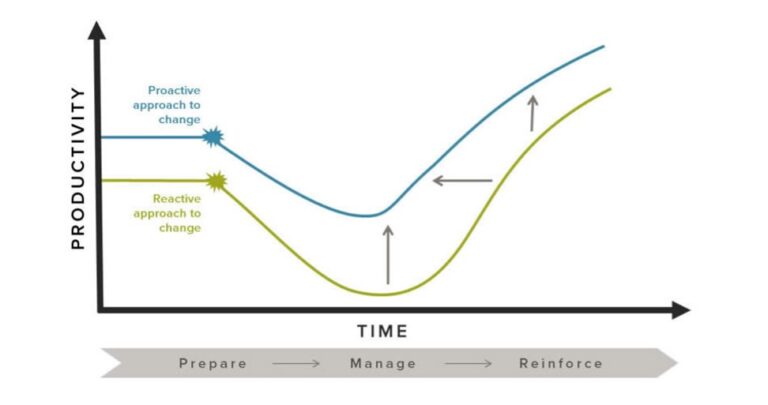
3 thoughts on “10 Reasons Your Initiative Needs an OCM Strategy”
Itís hard to find experienced people about this topic, but you seem like you know what youíre talking about! Thanks
Everything is very open with a precise clarification of the challenges. It was definitely informative. Your site is useful. Thanks for sharing!
דירות דיסקרטיות באילת
Thanks again!